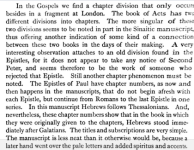WIkipedia begs to disagree with you. You need to note the meaning of the word "division" by Schneller. That's not to say there aren't sundry division marks or paragraphos in both manuscripts, but these bear little relation to anything in later manuscripts.Looks like Schneller writes whatever is convenient.
The “generally recognized” I’ll plan on its own post.
The “no question of a chapter division …. not a single paragraph” is total nonsense, for both manuscripts.
Codex Vaticanus. "The Greek lettering in the Codex is written continuously in small and neat letters.[11] All the letters are equidistant from each other; no word is separated from the other, with each line appearing to be one long word.[12]: 262–263 Punctuation is rare (accents and breathings have been added by a later hand) except for some blank spaces, diaeresis on initial iotas and upsilons, abbreviations of the nomina sacra and markings of OT citations.[11] The first letter of a new chapter sometimes protrudes a little from the column.[11] The OT citations were marked by an inverted comma or diplai (>).[11] There are no enlarged initials; no stops or accents; no divisions into chapters or sections such as are found in later manuscripts.[13]"
Codex Sinaiticus: Throughout the New Testament portion, the words are written in scriptio continua (words without any spaces in between them) in the hand-writing style that came to be called "biblical uncial" or "biblical majuscule". The parchment was ruled with a sharp point to prepare for writing lines. The letters are written along these lines, with neither breathings nor polytonic accents (markings utilised to indicate changes of pitch or emphasis).[12] A variety of types of punctuation are used: high and middle points; colon; diaeresis on initial iota and upsilon; a few ligatures are used, along with the paragraphos: initial letter into margin (extent of this varies considerably).
Last edited:

